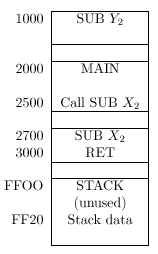| (a) |
Define each of the following terms: (i)operand (ii)opcode (iii)register (iv)interrupt (v)immediate addressing
|
[5] |
| (b) |
For each of the following definitions,give the name of the network topology being described. (i)A common carrier channel
over which data packets can be transmitted,either to a specific destination
or in a broadcast mode.
(ii)Nodes maybe fullyconnected,with everynode connected to everyother node,or partiallyconnected. (iii)All nodes are connected to a central controller which supervises the operation of the entire network.
|
[3] |
| (c) |
Show the steps of the execute cycle for the following instruction,which uses a three-address format (source,source,destination).Assume that initially,R1 contains the value 10,ABCD contains 20,and DCBA contains 30. MUL R1 ,[ABCD ],[DCBA ]
|
[8] |
| (d) |
Suppose that the general-purpose registers shown below have the values indicated,and that the steps of the program on the left are executed in sequence.Show all working,and with a diagram show how the values change in these general-purpose registers.

|
[4] |
| (e) |
The diagram below shows an example of a program loaded into memory,including some subroutines.Suppose that execution begins at MAIN.What will be the first subroutine call?How will the stack pointer and program counter change during the subroutine call?
|
[4] |
| (f) |
Describe three characteristics of a local area network (LAN) that distinguish it from other networks.
|
[3] |
| (g) | What is the lowest level of the OSI model?What features are covered bythis level? | [3] |
